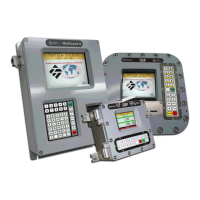Firmware Version 3/4.31.37
Delta Temperature is the difference between the measured temperature of the liquid and the reference
temperature. The API tables employed use reference temperatures of 60 F or 15 C.
Some API tables calculate the Alpha based on the liquid temperature and the API gravity of the liquid. The API
gravity is a user entered value, which is dependent on the type of liquid being measured. Other API tables
calculate the Alpha based on the liquid temperature and the relative density of the liquid. Still other tables
calculate the Alpha based on the liquid temperature and the density of the liquid. Liquid density, like API gravity,
is dependent on the type of liquid being measured. In the "C" tables, Alpha is user entered.
CPL Calculation- The Correction factor for Pressure of Liquid (CPL) is used to correct the Gross Volume to a
volume at the liquid's vapor pressure. After applying the CPL to the Gross Volume, the resulting net volume
represents the area that the liquid would occupy if the liquid were at its vapor pressure.
The calculation for CPL involves three variables: Variables include the current liquid pressure, the liquid's vapor
pressure and the F-factor of the liquid.
Current Pressure is the pressure of the liquid. This is a measured variable and will require that a pressure
transducer be employed to provide pressure information to a Flow Control Module (FCM) in the form of a 4-20 mA
signal.
Vapor Pressure is the pressure at which the liquid changes to vapor at the current liquid temperature. Vapor
pressure is also referred to as equilibrium pressure and bubble point. TP-15 is used to determine the vapor
pressure.
F-factor is the compressibility factor of the liquid. API tables 11.2.1 and 11.2.2 are used to compute the F-factor.
9.5 NET AND MASS CALCULATIONS
The MultiLoad II has the ability to calculate mass. Mass, for the purposes of this discussion, is defined to be the
net volume corrected to a density. The mass is calculated by multiplying the net volume by a density. There are 3
types of densities which can be used.
1/ Density
2/Relative Density
3/ API Gravity
The Density used in the mass formula follows the following rule.
If an API table is selected the API table determines the density
If no API table is selected the following rulez are going into affect.
- Check if there is a default density or relative density or API gravity
If not
- Check if a meter sensor is enabled for density or relative density or API gravity
If not
- Check if there is a default meter density or relative density or API gravity
This formular is used when we have a default density, relative density or API Gravity
Mass = Net Volume x Density
This formular is used when we measure the observed density
Mass = Gross Volume x Density
Note:

